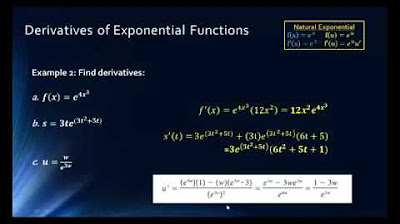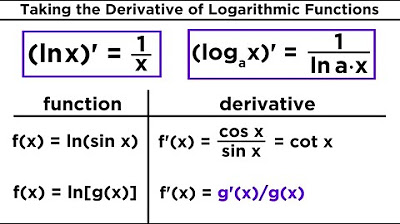Exponential functions differentiation intro | Advanced derivatives | AP Calculus AB | Khan Academy
TLDRThis video script delves into the concept of derivatives of exponential functions, highlighting the unique property of e^x and exploring how to find derivatives for exponential functions with bases other than e. By using logarithmic and exponent rules, the video demonstrates that the derivative of a^x is (natural log of a) * a^x, offering a practical approach to solving derivatives for a variety of bases.
Takeaways
- 📚 The derivative of e to the power of x (e^x) is e^x, showcasing the unique property of the exponential function with base e.
- 🔍 When exploring derivatives of exponential functions with different bases, the key lies in understanding how to express them in terms of the natural logarithm.
- 🌟 The derivative of a function a^x, where a is any number, can be found using the natural logarithm, leading to the expression (ln(a)) * a^x.
- 📈 By using algebra and exponent properties, we can rewrite a^x as e^( ln(a) * x ) to facilitate the calculation of its derivative.
- 🤔 The natural logarithm of a (ln(a)) represents the power to which e must be raised to obtain a, which is crucial for understanding the derivative of a^x.
- 📝 The derivative calculation involves applying the chain rule, taking the derivative of the outer function with respect to the inner function, and vice versa.
- 🧮 The derivative of a^x simplifies to ln(a) * a^x, which is a significant result for exponential functions with any base other than e.
- 🌈 To find the derivative of an expression with a different base, such as 8 * 3^x, multiply the coefficient (8) by the natural log of the base (ln(3)) and the base raised to the power of x.
- 🔧 The process of differentiating exponential functions with various bases is a practical application of logarithms and the chain rule in calculus.
- 🎓 Understanding the relationship between exponential functions, their derivatives, and the natural logarithm is fundamental for solving more complex calculus problems.
Q & A
What is the derivative of e to the x?
-The derivative of e to the x with respect to x is equal to e to the x. This is a unique property of the exponential function with base e.
If the derivative of a function at any point is equal to the value of the function itself, what kind of function is it?
-It is an exponential function with base e. This property is specific to the function with base e, making it stand out among other exponential functions.
How can we find the derivative of an exponential function with any base?
-We can use the property of logarithms and exponents to rewrite the exponential function with base 'a' as e to the power of the natural log of 'a' times x, and then apply the chain rule to find the derivative, which will be the natural log of 'a' times 'a' to the power of x.
What is the role of logarithms in finding the derivative of an exponential function with a different base?
-Logarithms are used to express the base 'a' in terms of 'e' by setting 'a' equal to 'e' to the power of the natural log of 'a'. This allows us to use the known derivative of e to the x to find the derivative of any exponential function.
What is the derivative of a to the x with respect to x?
-The derivative of a to the x with respect to x is the natural log of 'a' times 'a' to the power of x, which can be expressed as ln(a) * a^x.
How can we apply the chain rule to find the derivative of an exponential function?
-We apply the chain rule by first taking the derivative of the outer function (e to the natural log of a times x) with respect to the inner function (natural log of a times x), and then multiplying by the derivative of the inner function with respect to x (which is a constant, the natural log of a).
What is the derivative of 8 times 3 to the power of x?
-The derivative of 8 times 3 to the power of x is 8 times the natural log of 3 times 3 to the power of x, which can be written as 8 * ln(3) * 3^x.
What property of exponents allows us to simplify the derivative of an exponential function?
-The property that when raising a number to an exponent and then raising that result to another exponent, it is equivalent to raising the original base to the product of those exponents simplifies the derivative of an exponential function.
Why is understanding the derivative of exponential functions important?
-Understanding the derivative of exponential functions is important as it provides insights into the rate of change of these functions, which is crucial in many areas of mathematics, physics, and engineering.
How does the derivative of an exponential function with base 'a' relate to the natural log of 'a'?
-The derivative of an exponential function with base 'a' is directly proportional to the natural log of 'a', as seen in the expression ln(a) * a^x, which shows the close relationship between exponential and logarithmic functions.
What is the significance of the chain rule in calculus?
-The chain rule is significant in calculus as it allows us to find the derivative of composite functions, which are functions made up of one or more functions. It is a fundamental tool for differentiating complex functions.
Outlines
📚 Derivatives of Exponential Functions
This paragraph delves into the concept of taking derivatives of exponential functions, starting with the special case of e to the power of x, whose derivative is the function itself. It then explores the general case of a to the power of x, where 'a' can be any number. By using algebra and properties of exponents, the voiceover explains how to express 'a' as e to the natural log of 'a', which allows the application of the chain rule to find the derivative. The result is the natural log of 'a' times a to the power of x, highlighting the relationship between the derivative and the original function.
🔢 Application of Derivative Rules to Specific Exponentials
Building on the previous explanation, this paragraph applies the derived rules to a specific example, calculating the derivative of 8 times 3 to the power of x. By using the natural log property and the rules for derivatives of exponential functions, it is shown that the derivative is 8 times the natural log of 3 times 3 to the power of x, demonstrating how the general rule can be applied to find derivatives of expressions with different bases.
Mindmap
Keywords
💡Derivative
💡Exponential Functions
💡e (mathematical constant)
💡Natural Logarithm
💡Chain Rule
💡Logarithm Properties
💡Function's Slope
💡Algebra
💡Exponent Properties
💡Product Rule
Highlights
Exploring the derivatives of exponential functions is the main focus of the video.
The derivative of e^x with respect to x is equal to e^x, showcasing the unique property of the exponential function with base e.
The derivative of an exponential function a^x can be determined using algebra and exponent properties.
a can be expressed as e^(natural log of a), which is a key step in finding the derivative of a^x.
The natural log of a is the power required to raise e to obtain a, which is fundamental in rewriting a^x in terms of e.
The derivative of a^x with respect to x is the natural log of a times a^x, derived using the chain rule.
The derivative of e^(natural log of a) is a^(natural log of a), simplifying back to a.
The video demonstrates the application of this result to find the derivative of expressions with bases other than e.
The derivative of 8*3^x is calculated as 8*(natural log of 3)*3^x, as an example of applying the derived rule.
Understanding the derivative of exponential functions is crucial for various mathematical and practical applications.
The video emphasizes the importance of not just accepting the results but understanding the underlying mathematical concepts.
The chain rule is used to evaluate the derivative of the exponential function with a different base.
The derivative of a^x reveals the relationship between the base a, the natural log of a, and the exponential function.
The video provides a clear and detailed explanation of the process to find the derivative of a^x.
The natural log plays a pivotal role in transforming the base of the exponential function to facilitate the derivative calculation.
The video demonstrates the power of logarithmic and exponential functions in mathematical analysis.
The ability to find derivatives of exponential functions with any base is a valuable skill in advanced mathematics.
Transcripts
5.0 / 5 (0 votes)
Thanks for rating:





